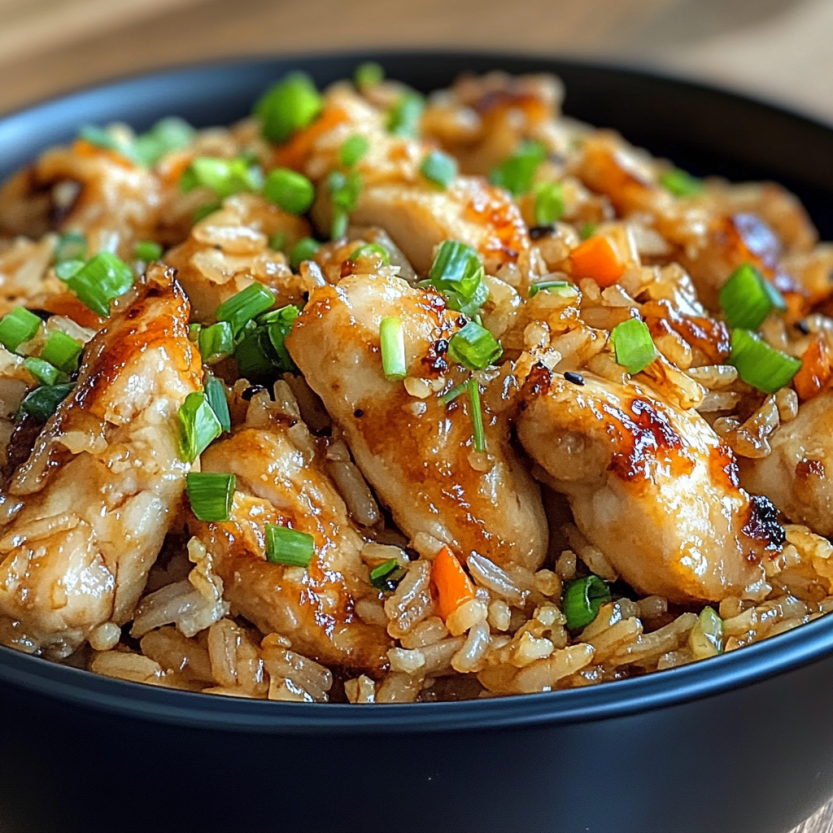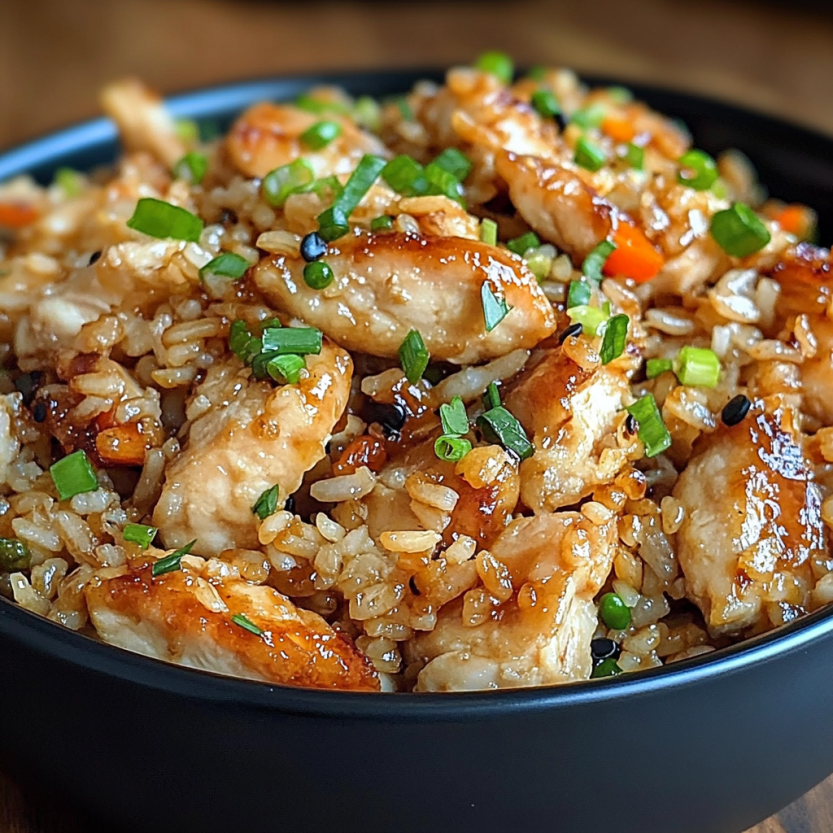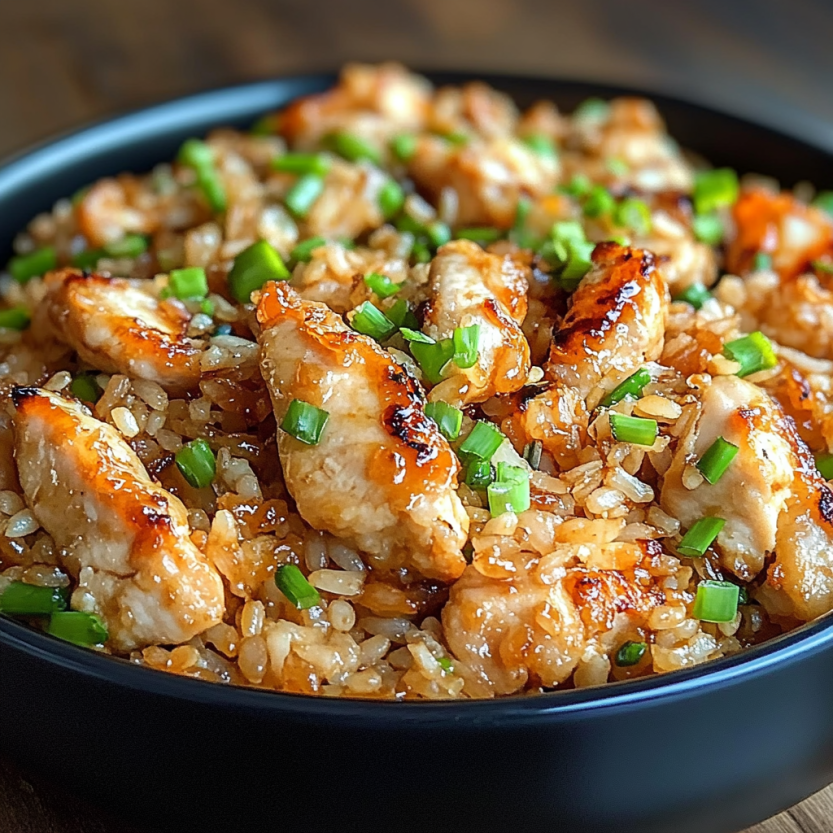 Save
Save
This hearty high-protein crispy garlic chicken fried rice has become my weeknight salvation when I need something quick yet satisfying. The combination of golden crispy chicken, fluffy eggs, and savory rice creates a complete meal that's as nutritious as it is delicious.
I first created this recipe during a particularly busy work week when I needed meals that would keep me energized through long days. Now it has become my go to post workout meal that delivers serious flavor without requiring serious cooking skills.
Ingredients
- Chicken breasts: fresh boneless and skinless yield the best texture and ensure maximum protein
- Cooked rice: day old refrigerated rice works best as it has less moisture for the perfect fried rice texture
- Olive oil: provides the base for crisping the chicken while adding heart healthy fats
- Garlic: freshly minced cloves deliver an aromatic punch that elevates the entire dish
- Green peas: adds vibrant color natural sweetness and extra protein even frozen works perfectly
- Diced carrots: brings natural sweetness and beautiful color contrast use fresh for best texture
- Eggs: creates silky richness throughout the dish while boosting protein content
- Low sodium soy sauce: provides the classic umami base without overwhelming saltiness
- Sesame oil: just a teaspoon transforms the dish with its distinctive nutty aroma
- Chili flakes: entirely optional but adds a pleasant warmth that complements the savory flavors
Step-by-Step Instructions
- Cook the Chicken:
- Cut chicken into small even cubes about half an inch in size for quick cooking. Heat your pan until it is quite hot before adding oil then chicken pieces. Allow them to sit undisturbed for about 2 minutes before stirring to develop that golden crust. Season generously as this layer forms the flavor foundation for the entire dish. The chicken should cook for approximately 5 to 7 minutes total until each piece has a satisfying crunch on the outside while remaining juicy inside.
- Sauté Garlic:
- After removing chicken add the minced garlic to the same unwashed pan to capture all those delicious browned bits. Keep the heat at medium to prevent burning as garlic can quickly go from perfect to bitter in seconds. Stir constantly for about 60 seconds until you can smell the intense aroma but before it takes on any color.
- Add Veggies:
- Introduce the carrots first as they take longer to soften approximately 2 minutes before adding the peas. If using frozen peas add them straight from the freezer their moisture will help deglaze the pan. Stir frequently ensuring even cooking while maintaining some texture in the vegetables. They should remain bright and slightly firm not mushy.
- Scramble the Eggs:
- Create a well in the center of your vegetables by pushing everything to the edges of the pan. Pour beaten eggs directly into this space and let them set for about 30 seconds before gently folding and breaking them into soft curds. The eggs should be just cooked through but still moist which takes approximately 60 to 90 seconds.
- Add Rice:
- Introduce the cold rice to the pan breaking any clumps with your spatula. Fold everything together rather than stirring vigorously to maintain the integrity of each component. Allow the rice to heat through untouched for about 30 seconds at a time before mixing again creating some lightly toasted grains for textural contrast.
- Season:
- Drizzle the soy sauce and sesame oil around the perimeter of the pan rather than directly onto the rice. This allows the seasonings to heat and distribute more evenly. Toss everything thoroughly ensuring each grain is coated with the savory mixture. Taste and adjust seasoning now rather than later.
- Combine Chicken:
- Reintroduce the crispy chicken along with any accumulated juices back into the pan. Gently combine everything ensuring the chicken remains crispy while absorbing the flavors of the rice mixture. This final step should take just 1 to 2 minutes until everything is piping hot.
- Garnish and Serve:
- Transfer to serving plates immediately while still steaming hot. A sprinkle of fresh herbs adds brightness and visual appeal that elevates the home cooking experience. Serve family style in a large bowl or individually plated for a more elegant presentation.
 Save
Save
The secret to this recipe is actually the cold rice. I discovered this technique after multiple failed attempts at making restaurant quality fried rice that always ended up soggy. When I started refrigerating rice overnight before cooking the difference was remarkable each grain remained distinct and chewy rather than clumping together.
Make Ahead Tips
This dish truly shines as a meal prep option. You can prepare the entire recipe and portion it into microwave safe containers for quick lunches throughout the week. The flavors actually improve after a day in the refrigerator as the rice continues to absorb the savory seasonings. When reheating simply sprinkle a few drops of water over the rice before microwaving to restore moisture without making it soggy.
Customization Options
The beauty of this recipe lies in its flexibility. Switch chicken for shrimp or tofu for equally delicious variations. Any vegetables work beautifully including bell peppers broccoli florets snap peas or mushrooms based on what looks fresh at the market. For a richer flavor profile try using butter instead of olive oil when cooking the chicken or add a drizzle of oyster sauce with the soy sauce for depth.
 Save
Save
Cultural Context
While this recipe takes inspiration from traditional Asian fried rice it represents a fusion approach focused on maximizing protein content. Traditional Chinese fried rice typically uses smaller amounts of meat as a flavoring component rather than a main ingredient. This adaptation emphasizes lean protein making it particularly suitable for contemporary health conscious eaters while maintaining the satisfying qualities of the original comfort food.
Serving Suggestions
This dish stands perfectly well on its own but pairs beautifully with a simple cucumber salad dressed with rice vinegar for a refreshing contrast. For a more substantial meal serve alongside miso soup or vegetable potstickers. I especially enjoy offering chili oil sriracha and extra soy sauce at the table so everyone can customize their bowl to their preferred spice level.
Recipe Questions
- → Why is cold rice recommended for this dish?
Cold rice is ideal because it's drier and the grains have firmed up, preventing them from becoming mushy during stir-frying. This results in distinct, separated grains that better absorb the flavors without clumping together. For best results, cook your rice a day ahead and refrigerate it overnight.
- → Can I substitute the protein in this dish?
Absolutely! While chicken provides excellent lean protein, you can substitute with firm tofu, shrimp, thinly sliced beef, or even additional eggs for a vegetarian version. Each alternative will offer different flavor profiles while maintaining the high-protein aspect of the dish.
- → What vegetables work well in this stir-fry?
Beyond the peas and carrots in the original recipe, great additions include diced bell peppers, broccoli florets, snap peas, corn kernels, mushrooms, or baby spinach. For best results, add firmer vegetables earlier in the cooking process and leafy greens at the very end.
- → How can I make this dish spicier?
To increase the heat level, try adding more chili flakes, fresh minced chilies, a tablespoon of sambal oelek or sriracha sauce, or a teaspoon of chili oil. You can also incorporate a dash of white pepper or a small amount of gochujang (Korean chili paste) for different spice profiles.
- → Is this dish suitable for meal prep?
Yes, this high-protein fried rice is excellent for meal prep! It stores well in airtight containers in the refrigerator for up to 3-4 days. The flavors often deepen overnight, making it even more delicious. For reheating, add a small splash of water before microwaving to restore moisture, or quickly reheat in a hot pan.
- → What type of rice works best for fried rice?
Medium to long-grain white rice like jasmine or basmati works best for fried rice due to their firm texture and tendency not to clump. Brown rice can be used for added nutrition, though it may result in a slightly chewier texture. Avoid short-grain or sticky rice varieties as they can become too gummy when stir-fried.